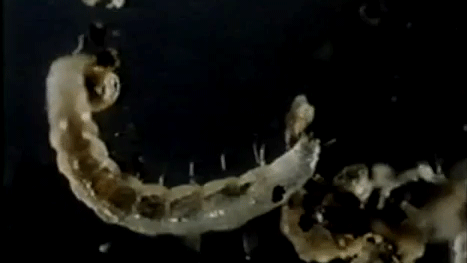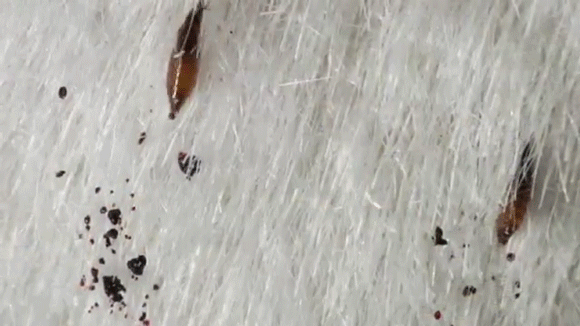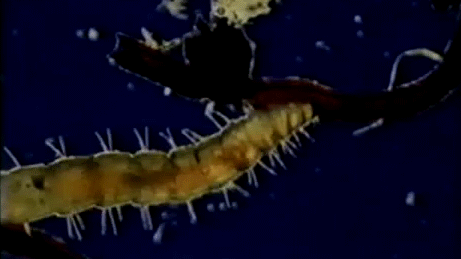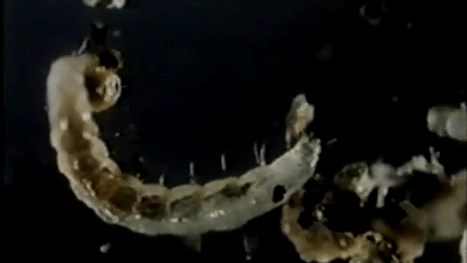
Img 1 Cat flea larvae primarily eat the feces from adults fleas. However, they also must consume conspecific eggs to fulfill their dietary requirements.
Summary
Flea larvae eat adult flea feces and conspecific eggs. The larvae need both components to fulfill nutritional requirements. They can’t survive by consuming only flea feces, or only eggs. Nearly all larvae live when they eat both foods.
Cat flea larvae don’t live on hosts and don’t feed parasitically. Instead, they scavenge for food in their environment. The larvae were once thought to gain nutrition from host-related debris. This has been refuted.
Details
How Flea Larvae Eat
Mouth Parts
Adult fleas have mouths for piercing skin and sucking blood. Larvae lack these mouth parts and instead possess powerful mandibles and mandibular teeth which are well-adapted for biting and chewing. This allows the “baby fleas” to be free-living, as they can nibble away at solid food sources.
Larvae are Scavengers
Cat flea larvae are scavengers. They don’t live on hosts, nor do they bite for blood. Instead, larvae graze for food in their habitat. Their movement is strongly influenced by food availability. When food is present, larvae stay within 16 cm from where they hatch. However, when food is absent, they’ll travel up to 90 cm to locate it. They must feed within 3 days to prevent starving.
What Flea Larvae Eat
Adult Fleas Feces
Primary Source of Nutrition
The primary food source for all larval instars is dried fecal blood from adult fleas. It’s commonly called flea dirt. Larvae can consume and utilize flea-digested blood from numerous host species.
Flea dirt provides larvae with their minimal nutritional requirements. They’ll fail to develop into adults without it. Even though the larvae don’t have a direct parasitic relationship with a host, they do require host blood to survive. Thus, they can still be technically classified as hematophagous obligate parasites.
Undigested Host Blood
Flea dirt is essentially dried host blood. Very little digestion takes place. Adults imbibe much more blood than they can use, and the undigested blood gets excreted. The excreta dries and breaks apart into reddish-black, pepper-like specks.

Img 2 An adult cat flea parasitically feeding and excreting fecal blood. This feces falls off the host and into the environment. It’s primary food source of larvae.
Both male and female adults produce fecal blood. The excreta contains the same amount of protein, regardless of gender. However, females produce a greater volume of feces. This indicates that females make a larger parental investment.
Hemoglobin, Protein & Ions
Fecal blood contains hemoglobin, which is essential for developing fleas. It provides larvae with the necessary iron for normal growth and sclerotisation into adults. The feces also has all of the essential proteins for larval development. It contains 83-90% of the protein from the original blood, and 44-80% of the ions (potassium and chloride).
Spherules & Coils
There are two types of feces: spherules and coils. Spherules are round, with diameters of 0.07-0.25 mm. Coils are long and average 0.84 mm in length. Spherules are produced when young adults consume their first blood meal. The feces transitions into mostly coils by the tenth day of feeding. Coils contain 33% more protein than spherules. The smaller, more manageable spherules are thought to be better for early stage larvae, while the protein-rich coils are more suitable for 3rd instars.

Img 3 Cat flea larva feeding on a coil of fecal blood. See Img 1 for what a spherule looks like.
Locations of Eggs & Flea Dirt
Since larvae rely so heavily on flea dirt, it must fall in the same locations as eggs. And it does. Excrement and eggs drop from hosts at the same time, resulting in similar spatial distributions. This leaves a protein-rich food available to larvae immediately upon hatching.
Eggs and fecal blood falling in the same location is partly due to females requiring a blood meal before every egg deposition. However, to a larger extent, it’s an elegant adaptation of flea saliva. When a flea feeds, its saliva causes skin irritation at the bite location. Animals then scratch themselves, dislodging both eggs and flea dirt.
The smooth eggs easily fall from the host even without scratching. However, the irregular-shaped fecal blood often only gets dislodged through grooming. As a result, feces and eggs are most commonly found together in areas where pets rest and groom themselves.
Conspecific Eggs
Flea Dirt isn’t Enough
Flea larvae can’t survive on a diet of fecal blood alone. In one study, 100% of larvae died when fed only cat blood. In another, only 13.3% of larvae reached maturity on a diet of purely fecal blood.
Based on past experiments, flea dirt alone was thought to provide enough nutrition for larval development. However, it was later discovered that larvae feed on conspecific eggs, both fertile and non-viable. It’s believed that larvae in these older studies supplemented their diets by consuming egg chorions.
Today, it’s known that flea larvae require at least two dietary components to successfully develop. Both are provided by adult fleas, in the form of fecal blood and conspecific eggs. Larvae can’t survive solely on blood, or solely on non-viable eggs. However, when they eat both, nearly 100% mature into healthy adults. The larvae prefer living in areas with both foods.
Number of Eggs Consumed
In one study, 7 non-viable eggs were consumed per larva. However, another study found that each larva would consume up to 21 dead eggs.
Eggs vs Flea Dirt
Young larval instars may prefer the soft eggs over hardened blood, because they’re easier to consume. Additionally, the eggs may have a higher nutritional value.
Non-Viable Eggs
Cat flea larvae can eat both fertile and non-viable eggs. A 3rd instar was observed sucking the yolk out of a fertile egg over 10 minutes. However, larvae are likely to prefer non-viable eggs. Fertile eggs have a round shape, causing them to roll away when larvae try to eat them. Non-viable eggs are flat, making them easier to grip and consume. Even without a preference, viable eggs are only vulnerable for 2 to 3 days before they hatch. Non-viable eggs accumulate in the environment, and may serve as food for future generations if they’re not consumed right away.
The production of non-viable eggs is an evolutionary adaptation of fleas. They serve as a nutrient supplement for larvae, and reduce cannibalization of fertile eggs. Female fleas lay non-viable eggs if they’re virgins, or if they haven’t mated with multiple males. Mated females also stop producing viable eggs a week after mating.
Cannibalism
In addition to eggs, flea larvae will cannibalistically feed on younger or injured larvae. They’ve also been observed consuming shed larval casings. 3rd instars may feed on naked pupae (no cocoon), or pupae within partial cocoons. However, complete cocoons protect the pupae from cannibalism, as does pupating within the safety of carpet fibers.
Organic Debris
Cat flea larvae were once thought to be detritivores, with a large part of their diets consisting of protein-rich organic debris in their environment. Examples of this detritus include feathers, cat feces, and decaying vegetable matter. However, these potential foods are of no value to flea larvae. In feeding trials, larvae don’t consume any of this organic matter. Host-associated materials (e.g. hair, dust, dead skin, fungi and microorganisms, dandruff, and food particles) can be found in their habit and possibly consumed, but the benefit it has to the larvae is minimal.
Artificial Foods
In laboratory experiments, flea larvae are sometimes fed blood combined with brewer’s yeast or Purina dog chow. A large percentage of larvae will survive on these artificial supplements.





You must log in to post a comment. Log in now.